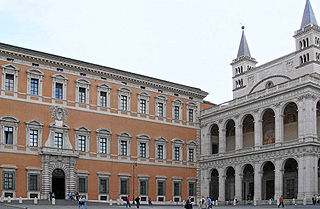
Vestararius
Encyclopedia

Roman Curia
The Roman Curia is the administrative apparatus of the Holy See and the central governing body of the entire Catholic Church, together with the Pope...
office of the vestiarium (cf. the Byzantine imperial wardrobe and treasury, the vestiarion
Vestiarion
The vestiarion , sometimes with the adjectives basilikon or mega , was one of the major fiscal departments of the Byzantine bureaucracy. In English, it is often known as the department of the Public Wardrobe...
), responsible for the management of papal finances as well as the papal wardrobe. The vestiarium is mentioned as the papal treasury as early as the seventh century, during the period of Byzantine cultural hegemony in the West called the "Byzantine Papacy
Byzantine Papacy
The Byzantine Papacy was a period of Byzantine domination of the papacy from 537 to 752, when popes required the approval of the Byzantine Emperor for episcopal consecration, and many popes were chosen from the apocrisiarii or the inhabitants of Byzantine Greece, Byzantine Syria, or Byzantine Sicily...
", but the vestararius itself is attested to only from the eight century.
Along with the highest financial officers arcarius and the sacellarius, the vestararius was one of the three most important staff officials of the Lateran Palace
Lateran Palace
The Lateran Palace , formally the Apostolic Palace of the Lateran , is an ancient palace of the Roman Empire and later the main Papal residence....
(the palatini). By the ninth century the vestararius was a member of the papal household second only to the seven judges, while the other two offices figured among the "seven judges of the palace" who constituted the core of the papal court. While the other offices were responsible for the collection and dispensation of papal assets, respectively, the vestararius was responsible for guarding the wealth, possibly depositing in the wardrobe along with the papal vestiments. The vestararius was also responsible for the written financial archives and accounts, and may have received and distributed some sums independently of the other offices.
By 813, the vestararius was seated beside the pope in the Palace in giving judgement and in 875 was sent as an embassy
Diplomatic mission
A diplomatic mission is a group of people from one state or an international inter-governmental organisation present in another state to represent the sending state/organisation in the receiving state...
to the Holy Roman Emperor
Holy Roman Emperor
The Holy Roman Emperor is a term used by historians to denote a medieval ruler who, as German King, had also received the title of "Emperor of the Romans" from the Pope...
. Theophylact I, Count of Tusculum
Theophylact I, Count of Tusculum
Theophylact I was a medieval Count of Tusculum who served Louis III, Holy Roman Emperor as judex and then was elected to head Rome as consul by the city's nobility in 915, an appointment that was confirmed by the Pope. He also was styled as senator, glorissimus dux, judex dativus, and magister...
, who for all intents and purposes ran the temporal affairs of the papacy during the saeculum obscurum of the first half of the tenth century, was a holder of the office of vestararius. His wife, Theodora, held the extraordinary position of vestararissa.
The financial administration of the papacy as a whole began to be referred to as a camera
Apostolic Camera
The Apostolic Camera, or in Latin Camera Apostolica or Apostolica Camera, is the central board of finance in the Papal administrative system, which at one time was of great importance in the government of the States of the Church, and in the administration of justice, led by the Camerlengo of the...
in 1017, but the name change may not have been of any real significance. The last known reference to the office of vestararius appears in 1033. There is no concrete evidence of continuity between the vestararius and the camerarius
Apostolic Camera
The Apostolic Camera, or in Latin Camera Apostolica or Apostolica Camera, is the central board of finance in the Papal administrative system, which at one time was of great importance in the government of the States of the Church, and in the administration of justice, led by the Camerlengo of the...
, which is referred to for the first time in 1099, although their functions are nearly the same. Either office (or both) may have existed during this period, or the responsibilities may have fallen to some third office, often hypothesized to have been filled by Hildebrand
Pope Gregory VII
Pope St. Gregory VII , born Hildebrand of Sovana , was Pope from April 22, 1073, until his death. One of the great reforming popes, he is perhaps best known for the part he played in the Investiture Controversy, his dispute with Henry IV, Holy Roman Emperor affirming the primacy of the papal...
.

